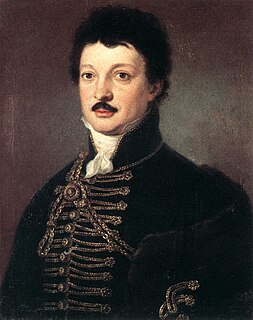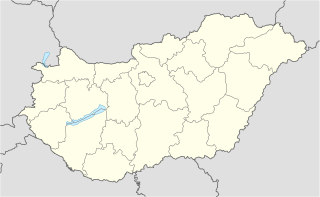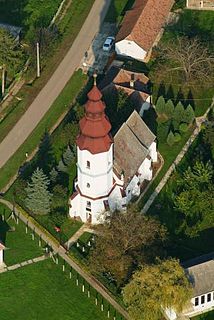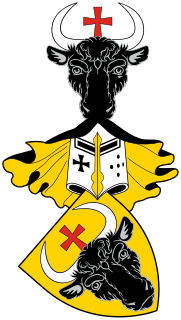Diósgyőr is a historical town in Hungary, today it is a part of Miskolc. The medieval castle in Diósgyőr was a favourite holiday residence of Hungarian kings and queens; today it is a popular tourist attraction. The city part has a heavy industrial background. The football team of Miskolc is also named after Diósgyőr; their soccer stadium lies within the district.

Dániel Berzsenyi was a Hungarian poet.

Beregsurány is a village in Szabolcs-Szatmár-Bereg county, in the Northern Great Plain region of eastern Hungary.

Nyírbátor is a town in Szabolcs-Szatmár-Bereg county, in the Northern Great Plain region of eastern Hungary. With its historic atmosphere, this city is known for its 15th- and 16th-century ecclesiastic and secular architectural heritage and for the Báthory family, former landowners.

Vámosoroszi is a village in Szabolcs-Szatmár-Bereg county, in the Northern Great Plain region of eastern Hungary. It is located in the eastern part of the county, on the Satu Mare Plain, near the Ukrainian border, and is inhabited by the Tapolnok stream.
Uszka is a village in Szabolcs-Szatmár-Bereg county, in the Northern Great Plain region of eastern Hungary. It is a small Hungarian village along the Hungarian-Ukrainian border.

Ura is a village in Szabolcs-Szatmár-Bereg County in the Northern Great Plain region of eastern Hungary. Small Hungarian village near the Hungarian-Ukrainian border.

Túristvándi is a village in Szabolcs-Szatmár-Bereg county, in the Northern Great Plain region of eastern Hungary. It is located in the eastern part of the county, in Satu Mare, on the shores of the Old Tour, in a wonderful natural environment, less than 5 kilometers from the Ukrainian border.

Tunyogmatolcs is a village in Szabolcs-Szatmár-Bereg county, in the Northern Great Plain region of eastern Hungary.

Tiszaberek is a village in Szabolcs-Szatmár-Bereg county, in the Northern Great Plain region of eastern Hungary.

Tiszamogyorós is a village in Szabolcs-Szatmár-Bereg county, in the Northern Great Plain region of eastern Hungary. East of Mándok, no. Tiszamogyorós is located in the North of Nyírség, in a landscape called Tiszamogyorós. The village, which suffered a lot from the floods of the Tisza, moved to its current fourth place in 1864.

Tiszakóród is a village in Szabolcs-Szatmár-Bereg county, in the Northern Great Plain region of eastern Hungary. To the west of the village is the river Túr. This is where the water of the Tour flows into the Tisza. The interesting thing about the place is that due to the often very high water level of the Tisza, the water of the Túr River is allowed into the Tisza through a so-called fall dam, so that during high water levels the Tisza does not swell back the Túr water. The walnut groves next to the ditch and the Túr, which flows like a waterfall, are a popular place for hiking and bathing in the area in summer.

Tiszadob is a village in Szabolcs-Szatmár-Bereg county, in the Northern Great Plain region of eastern Hungary.

Tiszadada is a village in Szabolcs-Szatmár-Bereg county, in the Northern Great Plain region of eastern Hungary.

Tiszabezdéd is a village in Szabolcs-Szatmár-Bereg county, in the Northern Great Plain region of eastern Hungary.

Tiszakanyár is a village in Szabolcs-Szatmár-Bereg county, in the Northern Great Plain region of eastern Hungary.

Timár is a village in Szabolcs-Szatmár-Bereg county, in the Northern Great Plain region of eastern Hungary.

Vácrátót is a village and commune in the comitatus of Pest in Hungary.

Győr was the name of a gens in the Kingdom of Hungary. The ancestor of the kindred was a German knight, who arrived to Hungary in the first half of the 11th century. His descendants settled down in Transdanubia. The last scion of the family died in the 17th century.

Hahót or Hahót–Buzád was the name of a gens in the Kingdom of Hungary, several prominent secular dignitaries came from this kindred. The last noble family, which originated from the kindred, became extinct in 1849.












